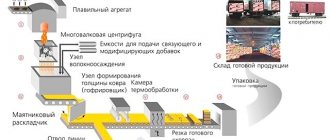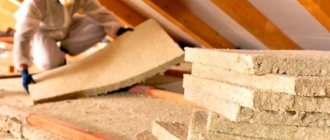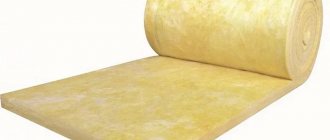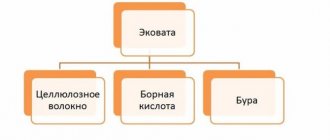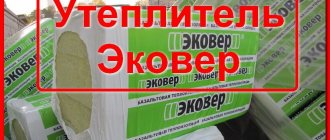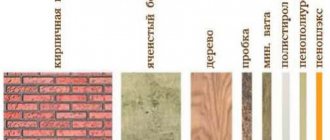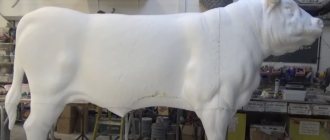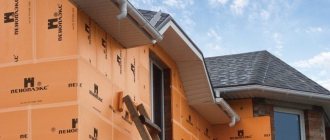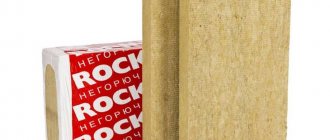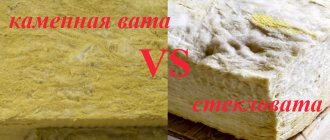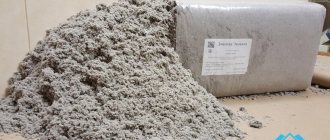Insulation for the home is rightly called “fur coat”. When it’s hot, it allows you to maintain a comfortable microclimate indoors; when it’s cold, it retains valuable heat. And when the time comes to choose such a “fur coat,” you have to prioritize: price or quality? Practicality or safety? Should you trust your neighbor's opinion or advertising? Let's look at insulation that manages to satisfy even the most demanding customers.
Thus, modern stone wool is one of the most environmentally friendly and reliable heat insulators. Its entire secret is in the air, which is in a motionless state between closely intertwined fibers. Which are also made from real stone! How can this even happen?
Now we will reveal all the secrets to you! From this article you will learn: what stone wool is and why it is valuable as insulation, how to use it and what features you should know about. After all, the debate about its practicality and environmental friendliness still does not subside, and the whole point is only in the raw materials used.
What is stone wool and how is it produced?
The method of making basalt wool itself, as they say, is borrowed from nature. When scientists studied a volcanic eruption in the Hawaiian Islands, they noticed the formation of thin threads that gathered into structures like cotton wool. This material was called quite funny - “Pele's hair”, and they tried to repeat the same process in modern construction.
This is how factories today simulate a volcanic eruption in special furnaces: the temperature reaches 1500°C, causing the rock to melt. Then the rocks are simply pulled out into fibers, and they are already connected with binding components into cotton wool of the desired consistency and shape. And most often such binders are synthetic.
After this, the compressed fibers are placed in a polymerization chamber. There, the fibers harden at a temperature of 200°C and form the final product, which is cut into rolls, slabs and mats. Next, they are packaged in a special shrink film:
Thanks to all this, modern stone wool is a heat-insulating material with a chaotic fibrous structure. This direction is given to the fibers by a pendulum spreader, which lays the fibers in several multidirectional layers. After this, the material is fed into the corrugator, and it already presses the wool into a certain carpet, with a clearly measurable density.
As a result, the resulting heat insulator has the following properties:
Basalt wool has always been in demand, even in times of crisis. From year to year, its sales increase by 7-9%. At the same time, competition between manufacturing companies is quite fierce, and many enterprises, in order to keep their product on the market, begin to enlarge (a good example is Isorok).
The leaders so far are TechnoNIKOL, which accounts for about 20%, and Rockwool, with a share of 20%. In total, there are currently about fifty factories in Russia that produce insulation in the form of stone wool.
Is there any harm to health during installation?
Work rules and safety equipment, as well as possible negative impacts on human health when working with stone wool, are regulated by the Interstate Standard “GOST 9573-2012 Thermal insulating mineral wool slabs with a synthetic binder.
Technical conditions". The very basis of the insulation (the natural species used) are safe substances, but resins containing phenol and formaldehyde in their composition are potential sources of danger to human health, while different researchers give completely contradictory conclusions on this matter. It is believed that thanks to a special production technology that ensures the neutralization of harmful substances, as well as their insignificant content per unit volume of insulation, stone wool is an environmentally friendly material.
Stone dust formed on the surface of the insulation has a negative impact on human health if it enters the respiratory tract. In this regard, when working with stone wool, it is necessary to use personal protective equipment - respirators, masks and protective gloves.
Work with stone wool is carried out in a respirator
Unique properties of basalt insulation
Let's look at the main properties of stone wool that make it a unique product.
Fire safety and reliability
As we have already said, stone wool is made today from the gabbro-basalt group, which is absolutely non-flammable. After all, the melting point of such fibers is within 1000°C. It is at this temperature that a stone melts, and finding one even in a strong fire is quite a challenge. This level of heating only occurs at the crater of a volcano. That’s why the most fire-hazardous places are insulated with stone wool.
Not only does stone wool not burn, but it also stops the heat from the fire, thereby protecting the internal building structures of the house. Not only to prevent them from burning, but also to prevent them from becoming deformed, collapsing and falling on people fleeing.
All this often provides additional valuable time for evacuation. If you have heard about fires, when a seemingly strong house flared up like a match and collapsed like a house of cards, it was precisely there that there were no such protective elements in the walls.
As you can see, almost all forms of stone wool belong to the non-combustible group:
Another important point is that even at high temperatures, stone wool does not emit toxic substances. This is also important, because often a fire is dangerous not so much because of the high temperature as because of the toxic air, which usually quickly spreads throughout the premises. And the more things in a residential building that burn easily, melt and stink, the worse it is.
Basalt wool is so fireproof that it is even used for underfloor heating:
Vapor permeability and “breathable” walls
Today, more and more often, owners of their own homes are asking an essential question: how environmentally friendly and safe is our own home? Is the microclimate in it comfortable, will mold be a problem?
And in this regard, two trends in approaching this issue have already developed today. The first is that the house should be like a thermos, and internal air exchange is organized using a supply ventilation system. The second is that the structures of a residential building must be “breathable” so that the house itself “breathes”, but not due to drafts of an unsealed structure, but due to the vapor permeability of the walls (this mainly applies to wooden buildings).
So, stone wool is also completely vapor permeable. Water vapor in the form of molecules easily passes through mineral thermal insulation and does not condense on the fibers. Thanks to this, the stone insulation does not get wet at all. That is why such insulation is ideal for arranging wooden baths, the walls of which, according to all the rules, should “breathe” and not be a dull thermos.
After all, the entire microclimate even in a residential building depends on whether the walls “breathe.” After all, remember that in our country the natural flow of air when the window is closed occurs due to a slight draft from windows and doors, while abroad they often install special supply ventilation for this purpose.
In any case, if it turns out that this is not enough, or the new plastic window turns out to be completely airtight and will block the already scarce micro-air flows, then the dampness will have nowhere to go. As a result, mold and a musty smell will appear in the house.
This is why advocates of environmentally friendly residential buildings talk about “breathable” walls. For this purpose, serious manufacturers issue stone wool with a special certificate, which allows it to be used for insulation of any room in the house, including children's rooms. The microclimate in such premises should be comfortable and safe. And steam can easily escape through the finishing and not linger in the insulation:
Durability and resistance to stress
The shrinkage of stone wool is so insignificant that it does not affect the durability of the thermal insulation at all. Thus, the geometric dimensions of the slabs are maintained throughout their entire service life, and therefore no cold bridges arise.
In addition, mineral slabs have low hygroscopicity - only 0.5% of the volume. Just in case, today stone wool is additionally impregnated with special water-repellent compounds - water repellents. These are oils or organosilicon compounds.
This is necessary in order to keep the wool in the desired condition during its installation. After all, important construction work is often carried out in wet weather, and even when it rains.
And finally, stone wool has high chemical resistance and does not cause corrosion to metal.
Environmental debate
Stone wool is rightfully considered one of the most environmentally friendly, and the products of some manufacturers even have an Eco Material Green certificate.
But let's add a little tar here. There are studies that basalt wool may be unsafe. Back in 1995, the prospectuses of some companies stated that basalt fibers are glued together with synthetic resin, which is obtained by condensation of phenol and formic aldehyde. And the resin differs significantly in its qualities from the fibers themselves. So, in the oven they do not melt to temperatures above 1000 degrees, but resin does not melt at 200 degrees. The dust from cotton wool itself is also dangerous.
The manufacturers themselves claim that the phenol-formaldehyde binder they use in the process of making cotton wool contains very little of it and cannot pose any threat to human health. But back in 1997, the European Union published a classification of insulating materials, where mineral wool was recognized as potentially hazardous depending on its content of alkaline earth metals and alkali oxides.
Unfortunately, today some manufacturers make cotton wool based on a binder such as phenol-formaldehyde. And these are already dangerous volatile compounds, poisonous, belonging to the second class of danger.
Surely you know that formaldehyde is highly toxic, allergenic, mutagenic and carcinogenic. And in stone wool slabs the binder usually contains from 3 to 6%. In addition, there is quite a lot of this substance in the surrounding space, even in the street air, and especially in low-quality furniture, i.e. it accumulates.
Manufacturers actually say that at a temperature of 250°C the binder begins to burn, but the structure of the mineral wool does not oxidize or change. That’s why, if the environmental friendliness of the finishing materials used is important to you, look at the documents for the selected stone wool option: what kind of binder is used there? Resin or starch?
Another important point. Unlike glass wool, basalt wool does not release thousands of small needles into the air, which is the difference between stone wool and glass wool - but you should also work with it carefully! Please note that abroad workers in protective clothing and a mask insulate walls with it, although our home craftsmen like to take glass wool with their hands. After all, basalt fiber produces fine dust, especially when shaking the slabs.
By the way, TechnoNIKOL once conducted a rather interesting study of buyer expectations. And it turned out that for 87% of those surveyed, the main criterion for choosing construction and finishing materials was environmental friendliness.
It was for this purpose that GreenGuard insulation was developed, which today is called something of an eco-breakthrough in modern construction. We'll tell you about it a little later.
Cost in Russia
The table shows average prices for insulation in different regions of the country. Dimensions vary from 600x800 to 600x1000 mm, thickness 20-150 mm.
| Region | Stone wool (slab 4 m per pack) | Glass wool (mat 8-10 m) | Ecowool (packaging) |
| Moscow | 580-820 | 1800-2300 | 580 |
| Saint Petersburg | 250-800 | 1400-2800 | 530 |
| Ekaterinburg | 400-700 | 1000-2500 | 600 |
The question of density and quality: is more always better?
Today, many people believe that the higher the density of stone wool, the more practical it is. Actually this is not true. Density has its own clear indicators for use in different conditions.
So, stone wool with a density:
- up to 35 kg/m3 ideal for unloaded surfaces such as roof slopes. It is easily installed between the rafters and holds well between them due to the fact that it is not pulled down by its own weight;
- slabs with a density of 35 to 75 kg/m3 are used for the floor, ceiling and interior walls of the house;
- stone wool with a density of 75 to 125 kg/m3, quite heavy, is used for facade systems.
Each modern stone wool manufacturer has a separate product line for this, with its own clear density:
In general, the thermal conductivity of a material depends on the density of the wool. And density depends on the ordering of the fibers. So, the more vertical fibers you have, the better the thermal insulation itself, and the higher the compressive strength of the slab.
Manufacturers noticed this point and today they are trying to make cotton wool less dense and heavy, but at the same time just as heat-insulating and anti-shrink. In a word, the density of stone wool itself is not linearly related to its strength. So, the less dense the wool with the same strength, the initially the technological process of its production was of high quality.
In addition, there is far more than one spectrum of strength: tensile, compressive, and suited to the task at hand. Thus, roof insulation on flat roofs and screed floors always work in compression. But this same parameter has practically no meaning when it comes to insulating ventilated facades. After all, the strength of the wool to tear off layers is already important here! And there is no compression here.
But if we are talking about layered brickwork, the thermal insulation should be both light and durable, like Rockwool Light Butts Extra slabs. Their density is in the range of 40-50 kg/m3 and tensile strength is 8 kPa.
Insulation of facades with mineral wool
Insulation technology is carried out in three ways:
- The wet method involves gluing the wall surface with slabs and then applying plaster. This method is most often used for thermal reconstruction of already built houses. It is suitable for wooden and brick houses.
- A ventilated facade is a method of arranging a frame, inside of which there are tightly laid slabs. There is a ventilation gap between the cladding and the insulation. This method is suitable for any house (wooden, brick or concrete panels).
- A well is a method of placing mineral wool inside a wall between panels or blocks of a brick house.
New products on the market: convenient format and high environmental friendliness
Due to the constant competition for their place in the sun, manufacturers are constantly improving the quality of their products or coming up with new products that cannot fail to interest potential buyers.
Let us separately note the popular new product from Rocklight – Rocklight Mini. These are stone wool slabs measuring only 800x600 mm, compared to the more common 1200x600 mm. This format allows you to more accurately calculate the required amount of insulation, avoid mistakes and more conveniently deliver the slabs in your own car.
The eco-friendly insulation GreenGuard, developed using GEOlife technology from TechnoNIKOL, is quickly becoming famous. The peculiarity of the technology is that exclusively natural components are used here: only rocks of the basalt group and biopolymer binders of organic rather than synthetic origin. This type of rock is characterized by high refractoriness, and therefore cotton wool is quite fire-resistant. Therefore, the material is assigned the maximum fire safety class.
Such insulation not only does not burn and does not change shape, but also serves as a certain barrier to fire. And at the same time there will be no poisonous gases or toxic substances, because there are no resins here at all. Modified starch and an organic thickener are used as a binder. The same substances are used today in the food, perfume and diaper industries.
What is the material?
Soft insulation, which is made from fibers of natural materials of different origins, mixed with phenol-formaldehyde resins. Mineral wool is produced in rolls, slabs or loose form.
The thickness of the roll or slab ranges from 50 to 150 mm. The insulation is light in weight and has varying degrees of plasticity. Thermal conductivity is minimal, varying from 0.029 to 0.48 W/m*C.
Reasons why mineral wool is popular in the market:
- ease of use;
- moderate cost;
- low thermal conductivity;
- can withstand temperatures up to 700°C;
- is not subject to rotting and destruction by mice and insects.
For insulation of wooden houses it is chosen for its resistance to fire.
The thermal insulation properties of a 15-18 cm layer of wool are equal to a 46 cm wall made of foam concrete, a 50 cm wall made of timber, a 90 cm wall made of expanded clay and a 146 cm wall made of brick. Despite all the advantages of this material, it is not protected from moisture absorption.
If mineral wool is not isolated from moisture from the environment, it will begin to accumulate water, losing its thermal insulation properties.
Therefore, when laying it, it is insulated on both sides with vapor and waterproofing .
General Tips
A few rules and notes for quality work.
How to choose and apply glue to mineral wool
Without the correct selection and use of glue, the insulation may sag and cease to act effectively. Stone wool is a rather unusual material, and not every adhesive can provide high-quality adhesion to the wall.
Polymer-cement compositions will provide the highest adhesion. They are sold as a dry mixture similar to cement. There are several well-known brands: “EK THERMEX”, “ERESIT CT190”, “ERESIT CT180”.
Following the instructions on the package, dilute the mixture with water and mix well (repeat after 5 minutes). The solution will retain its adhesive properties for 2 hours.
Apply the solution evenly onto a flat surface of the wall so that you get 7-8 glue circles. We also apply glue to the back side of the cotton wool (closer to the edges); the surface should be covered with the composition more than half. It is also better to coat the joints. The glue hardens for some time, so it is possible to lay the slab correctly. Attaching stone wool to a wall is simple.
Sometimes, for greater reliability, additional fastening may be required. Anchor bolts or slats secured to the sheathing can help here.
How to calculate layer thickness?
To calculate the thickness of the required insulation layer, special calculations should be carried out.
This will not be difficult if you use an online calculator. In general terms, the calculation scheme is based on the physical parameters of the substances and established building standards. For example, in Moscow SNiPs establish that the insulation of all types of floors should provide resistance to heat transfer, R = 4.15 m2C/W. When polystyrene foam with a thermal conductivity of 0.04 W/mS is used, the required coating thickness is calculated as follows: 4.15 x 0.04 = 0.166 m. Polyurethane foam will require a layer thickness of 125 mm, and expanded clay should be 415 mm in height.
Fastening requirements
Insulation anchors are subject to high stress, function in alkaline environments and are exposed to extreme temperatures. This means they must meet several criteria.
Be resistant to destruction. Both the umbrella itself and the nail must be of very high strength. The nail must be made of galvanized steel so that its material does not react and begin to deteriorate
This is especially important when the material under the “wet facade” is attached with fungus. With this approach, the fungus is covered with a layer of plaster and becomes “immured” in alkali. When passing through thermal insulation, the fungus can become a “cold bridge”
This will not happen if the material from which the fastener is made has low thermal conductivity. A thermal conductivity index higher than 0.004 W/K is considered unacceptable. Ensure high adhesion. In the case of ventilated facades, fungus often serves as the only retaining factor for thermal insulation. “Wet” ones also contain foam adhesive, but the load is much higher. The fungus must provide sufficient adhesion to the surface of the insulation and the main material of the wall. In addition, if foam or fiberglass insulation is reinforced with an adhesive layer on top, the cap must become one with this wet compound, providing a layer of insulation.
We have set the basic requirements for fasteners for insulation; now it is important to see how the modern market satisfies these requirements. To put it simply, there are two main types of umbrellas
To put it simply, there are two main types of umbrellas.
Made from galvanized steel
The nail of such umbrellas in most cases is made of galvanized steel (sometimes polyamide). And although this material resists corrosion more than other metal ones, it is still not completely protected from it. There is a second drawback. Metal conducts heat well, which means that cold bridges can form at the attachment point and condensation can accumulate. Over time, cracks may appear at the attachment points. This type of fasteners has a higher cost.
- Dowel material: impact-resistant polypropylene.
- Anchor material: low carbon, galvanized steel;
- Temperature range: -55 - +60 degrees;
- Load: up to 750 kg per square meter.
As a conclusion: such fungi are used in the case of attaching heavy insulation, when the use of plastic is impossible.
Made of plastic
Dowel for thermal insulation with a plastic nail. They are used more often than metal ones, but they are less expensive and less durable. Although even their performance is quite impressive. The temperature ranges from -40 to + 80 degrees. Such umbrellas are also able to withstand loads from 20 to 380 kg per square meter. Nylon nails are also classified as plastic.
Thermal insulation dowels with thermal head are umbrellas with metal nails. A polymer head is placed on the end of the anchor. This approach is used for different types of walls, but is especially necessary for wooden ones. The purpose of the head is to reduce thermal conductivity. Such elements have a higher cost (the highest among dowels), but also the lowest thermal conductivity and strength.
In addition, fungi are distinguished by length. This is an important indicator that needs to be calculated correctly. The diameter of the rod for the anchor is also distinguished. Most often, rods with a diameter of 8-10 mm are used.
Practical tips
In this short section we have collected useful, practical tips that will help when installing thermal insulation.
- If you use polystyrene foam, moisten it with water before applying the foam adhesive. This will improve the adhesion (adhesion) of the foam and the sheet.
- When insulating walls outside, there may be a blockage - a protrusion at the bottom of the wall of the house. In this case, the base profile does not need to be installed. Simply cover the pile with waterproofing to prevent moisture from getting into the insulator.
- Insulation sheets should always be fastened in a checkerboard pattern. This is necessary for inconsistency of seams. This fastening allows you to avoid cold bridges.
- Do not leave fixed material on the wall unprotected. Putty foam or hard stone wool or cover soft slabs with a windproof layer immediately. If moisture gets into the thermal insulation during the installation stage, the material will do its job very poorly.
We looked at the general principles of how to attach mineral wool or other thermal insulation. As you can see, attaching insulation to the wall is a non-trivial task, but it requires some skills.
And one more trick:
Insufficient fastening of thermal insulation to the load-bearing surface
This may be the result of careless application of adhesive, the use of materials with inappropriate parameters, or too weak mechanical fastening. Mechanical connections are all kinds of dowels and anchors. Do not skimp on the mechanical fastening of insulation, be it heavy mineral wool or lightweight foam.
The place of fastening with a dowel must coincide with the place where the glue (blooper) is applied on the inside of the insulation
The dowels must be properly embedded in the insulation. Pressing too deeply leads to damage to the insulation boards and the formation of a cold bridge. Too small and it will cause a bulge that will be visible on the façade.
Why insulate?
For comfortable living conditions in winter, houses are heated, consuming a huge amount of coolant. Every year the cost of heating only increases. In order to save costs and reduce heat loss, energy-saving double-glazed windows are installed and walls, floors and ceilings are insulated with heat-insulating materials.
More than a third of a home's heat escapes through the roof as warm air rises. Through an uninsulated ceiling, warm flows leave the living spaces and rush into the attic, where, in contact with the roof covering, they form condensation on the floor beams and rafter system. High humidity leads to material deterioration and fungal growth, reducing the durability of the roofing structure.
If the attic space is actively used or serves as an attic, then the roof itself is insulated. When the attic is not in use, the attic floor is insulated. Installation is carried out on the beams of a cold attic.
In this case, you can achieve multifunctionality of the insulation:
- protection from hot hot air in the attic in the summer allows the living space to remain cool;
- sound absorption function: noise from howling wind and precipitation is reduced;
- retention of warm air indoors during the heating season is achieved by creating an insulating barrier.
Application of dry mixtures
When choosing dry glue for gluing mineral wool, it should be taken into account that it will require the builder to strictly follow the dilution instructions, thoroughly mix and take time to “ripen” (several minutes).
After this, the glue is applied to the insulation in wide strips (up to 10 cm) and the insulation is glued to the prepared base. There will be about 7 minutes left for adjustments. Next comes a thin layer of glue (up to 15 cm wide), on which reinforcing material is applied.
Here you need to take into account one important nuance: dry mixtures (mainly cement-based) are more advisable to use if there is a need to level the walls before insulation. That is, it will be both glue and leveling compound. Such combinations are very economical for a limited budget.
With the right choice of glue, insulation material and type of insulation, as well as the correct installation work, the result will be a durable and warm house - the dream of any resident.
With a significant jump in prices for utility bills, many homeowners began to clearly think about the through-flow of money from the family budget through existing house cracks. For residents of multi-storey buildings, external insulation of one apartment is possible, but one should not expect very positive results. To finally stop the leakage of warm air, a more serious and global approach is needed - insulation work should be carried out in the volumes and parameters of the entire building. The external method of insulating a house using mineral wool is very effective.
